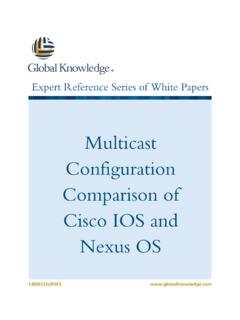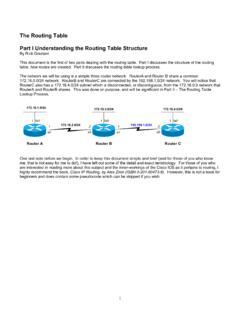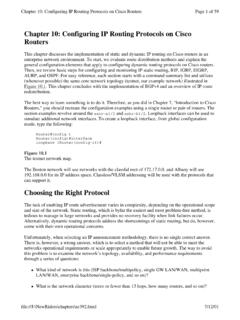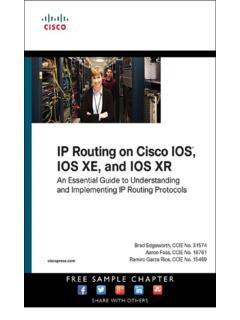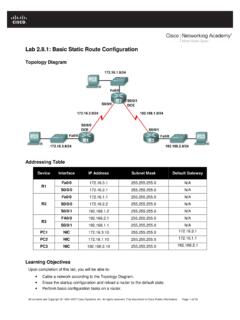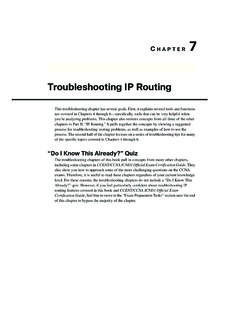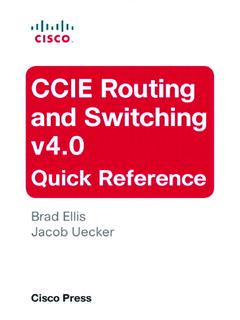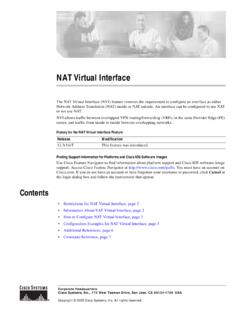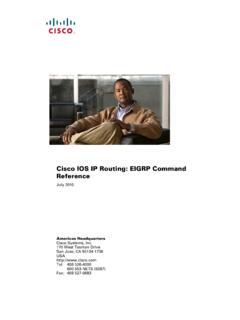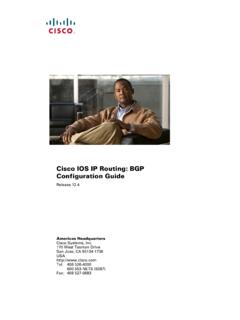Transcription of Integrated IS-IS Commands - Cisco - Global Home Page
1 IP2R-195 Cisco IOS IP command Reference, Volume 2 of 3: routing Protocols Integrated IS-IS CommandsUse the Commands in this chapter to configure and monitor the Intermediate System-to-Intermediate System ( IS-IS ) protocol. For IS-IS configuration information and examples, refer to the Configuring Integrated IS-IS chapter of the Cisco IOS IP Configuration IS-IS Commandsarea-passwordIP2R-196 Cisco IOS IP command Reference, Volume 2 of 3: routing Protocolsarea-passwordTo configure the IS-IS area authentication password, use the area-password command in router configuration mode. To disable the password, use the no form of this passwordno area-password [password]Syntax DescriptionDefaultsNo area password is defined, and area password authentication is ModesRouter configurationCommand HistoryUsage GuidelinesUsing the area-password command on all routers in an area will prevent unauthorized routers from injecting false routing information into the link-state password is exchanged as plain text and thus this feature provides only limited password is inserted in Level 1 (station router level) protocol data unit (PDU) link-state packets (LSPs), complete sequence number PDUs (CSNPs), and partial sequence number PDUs (PSNP).
2 ExamplesThe following example assigns an area authentication password:router isisarea-password angelRelated Commandspassword Password you command was Descriptiondomain-passwordConfigures the IS-IS routing domain authentication passwordConfigures the authentication password for an IS-IS Commandsdefault-information originate ( IS-IS )IP2R-197 Cisco IOS IP command Reference, Volume 2 of 3: routing Protocols default-information originate ( IS-IS )To generate a default route into an IS-IS routing domain, use the default-information originate command in router configuration mode. To disable this feature, use the no form of this command . default-information originate [route-map map-name]no default-information originate [route-map map-name]Syntax DescriptionDefaultsThis command is disabled by ModesRouter configurationCommand HistoryUsage GuidelinesIf a router configured with this command has a route to in the routing table, IS-IS will originate an advertisement for in its link-state packets (LSPs).
3 Without a route map, the default is only advertised in Level 2 LSPs. For Level 1 routing , there is another mechanism to find the default route, which is to look for the closest Level 1 or Level 2 router. The closest Level 1 or Level 2 router can be found by looking at the attached-bit (ATT) in Level 1 route map can be used for two purposes: Make the router generate default in its Level 1 LSPs. Advertise 0/0 conditionally. With a match ip address standard-access-list command , you can specify one or more IP routes that must exist before the router will advertise 0 following example forces the software to generate a default external route into an IS-IS domain:router isis! BGP routes will be distributed into IS-ISredistribute bgp 120! access list 2 is applied to outgoing routing updatesdistribute-list 2 outdefault-information originate!
4 Access list 2 defined as giving access to network 2 permit map-name(Optional) routing process will generate the default route if the route map is command was IS-IS Commandsdefault-information originate ( IS-IS )IP2R-198 Cisco IOS IP command Reference, Volume 2 of 3: routing ProtocolsRelated CommandsCommand Descriptionredistribute (IP)Redistributes routes from one routing domain into another routing isis databaseDisplays the IS-IS link-state IS-IS Commandsdomain-passwordIP2R-199 Cisco IOS IP command Reference, Volume 2 of 3: routing Protocols domain-passwordTo configure the IS-IS routing domain authentication password, use the domain-password command in router configuration mode. To disable a password, use the no form of this passwordno domain-password [password]Syntax DescriptionDefaultsNo password is specified and no authentication is enabled for exchange of Level 2 routing ModesRouter configurationCommand HistoryUsage GuidelinesThis password is exchanged as plain text and thus this feature provides only limited password is inserted in Level 2 (area router level) protocol data unit (PDU) link-state packets (LSPs), complete sequence number PDUs (CSNPs), and partial sequence number PDUs (PSNPs).
5 ExamplesThe following example assigns an authentication password to the routing domain:router isisdomain-password flowerRelated Commandspassword Password you command was Descriptionarea-passwordConfigures the IS-IS area authentication passwordConfigures the authentication password for an IS-IS Commandshello paddingIP2R-200 Cisco IOS IP command Reference, Volume 2 of 3: routing Protocolshello paddingTo reenable IS-IS hello padding at the router level, enter the hello padding command in router configuration mode. To disable IS-IS hello padding, use the no form of this paddingno hello paddingSyntax DescriptionThis command has no arguments or hello padding is ModesRouter configurationCommand HistoryUsage GuidelinesIntermediate System-to-Intermediate System ( IS-IS ) hellos are padded to the full maximum transmission unit (MTU) size.
6 The benefit of padding IS-IS hellos to the full MTU is that it allows for early detection of errors that result from transmission problems with large frames or errors that result from mismatched MTUs on adjacent can disable hello padding in order to avoid wasting network bandwidth in case the MTU of both interfaces is the same or, in case of translational bridging. While hello padding is disabled, Cisco routers still send the first five IS-IS hellos padded to the full MTU size, in order to maintain the benefits of discovering MTU mismatches. To disable hello padding for all interfaces on a router for the IS-IS routing process, enter the no hello padding command in router configuration mode. To selectively disable hello padding for a specific interface, enter the no isis hello padding command in interface configuration mode.
7 ExamplesIn the following example the no hello padding command is used to turn off hello padding at the router level:Router(config)#router isisRouter(config-router)#no hello paddingRouter(config-router)#endThe show clns interfaces command is entered to show that hello padding has been turned off at router level:Router#show clns interface e0/0 Ethernet0/0 is up, line protocol is upChecksums enabled, MTU 1497, Encapsulation (5)TThis command was introduced. (5)SThis command was Integrated into Cisco IOS Release (5)S. Integrated IS-IS Commandshello paddingIP2R-201 Cisco IOS IP command Reference, Volume 2 of 3: routing Protocols ERPDUs enabled, min. interval 10 fast switching enabledCLNS SSE switching disabledDEC compatibility mode OFF for this interfaceNext ESH/ISH in 4 secondsRouting Protocol: IS-ISCircuit Type: level-1-2 Interface number 0x0, local circuit ID 0x1 Level-1 Metric: 10, Priority: 64, Circuit ID: IPv6 Metric: 10 Number of active level-1 adjacencies: 1 Level-2 Metric: 10, Priority: 64, Circuit ID: IPv6 Metric: 10 Number of active level-2 adjacencies: 1 Next IS-IS LAN Level-1 Hello in 6 seconds!
8 No hello paddingNext IS-IS LAN Level-2 Hello in 2 seconds! No hello paddingWhen the debug isis adj packets command is entered, the output will show the IS-IS hello protocol data unit (PDU) length when a hello packet has been sent to or received from an IS-IS adjacency. In the following example the IS-IS hello PDU length is 1497:Router#debug isis adj packets e0/0IS-IS Adjacency related packets debugging is onRouter_A#*Oct 11 18:04 : ISIS-Adj: Sending L1 LAN IIH on Ethernet0/0, length 55*Oct 11 18:04 : ISIS-Adj: Rec L2 IIH from (Ethernet0/0), cir type L1L2, cir id , length 1497 Related CommandsCommand Descriptionisis hello paddingReenables IS-IS hello padding at the interface isis adj packetsDisplays information on all adjacency-related activity such as hello packets sent and received and IS-IS adjacencies going up and clns interfaceLists the CLNS-specific information about each IS-IS Commandshostname dynamicIP2R-202 Cisco IOS IP command Reference, Volume 2 of 3.
9 routing Protocolshostname dynamicTo enable IS-IS dynamic hostname capability on the router, use the hostname dynamic command in router configuration mode. To disable the dynamic hostname feature, use the no form of this dynamicno hostname dynamicSyntax DescriptionThis command has no arguments or DefaultThe dynamic hostname feature is enabled by ModesRouter configurationCommand HistoryUsage GuidelinesIn the IS-IS routing domain, the system ID is used to represent each router. The system ID is part of the network entity title (NET) that is configured for each IS-IS router. For example, a router with a configured NET of has a system ID of Router-name-to-system-ID mapping is difficult for network administrators to remember during maintenance and troubleshooting on the routers. Entering the show isis hostname command displays the entries in the system-ID-to-router-name mapping dynamic hostname mechanism uses link-state protocol (LSP) flooding to distribute the router-name-to-system-ID mapping information across the entire network.
10 Every router on the network will try to install the system ID-to-router name mapping information in its routing a router that has been advertising the dynamic name type, length, value (TLV) on the network suddenly stops the advertisement, the mapping information last received will remain in the dynamic host mapping table for up to one hour, allowing the network administrator to display the entries in the mapping entry during a time when the network experiences problems. Entering the show isis hostname command displays the entries in the mapping defined mappings are always preferred over dynamicly learned mappings. If you have already configured the clns host command to overwrite network advertised name mappings from LSPs, the clns host command will take precedence over the dynamic hostname command was command was Integrated into Cisco IOS Release (S).
